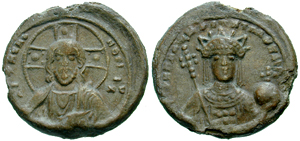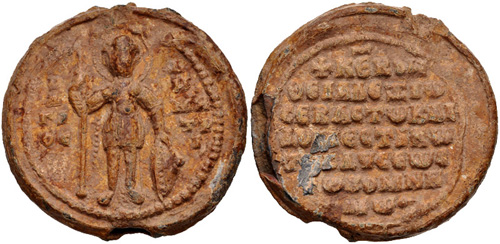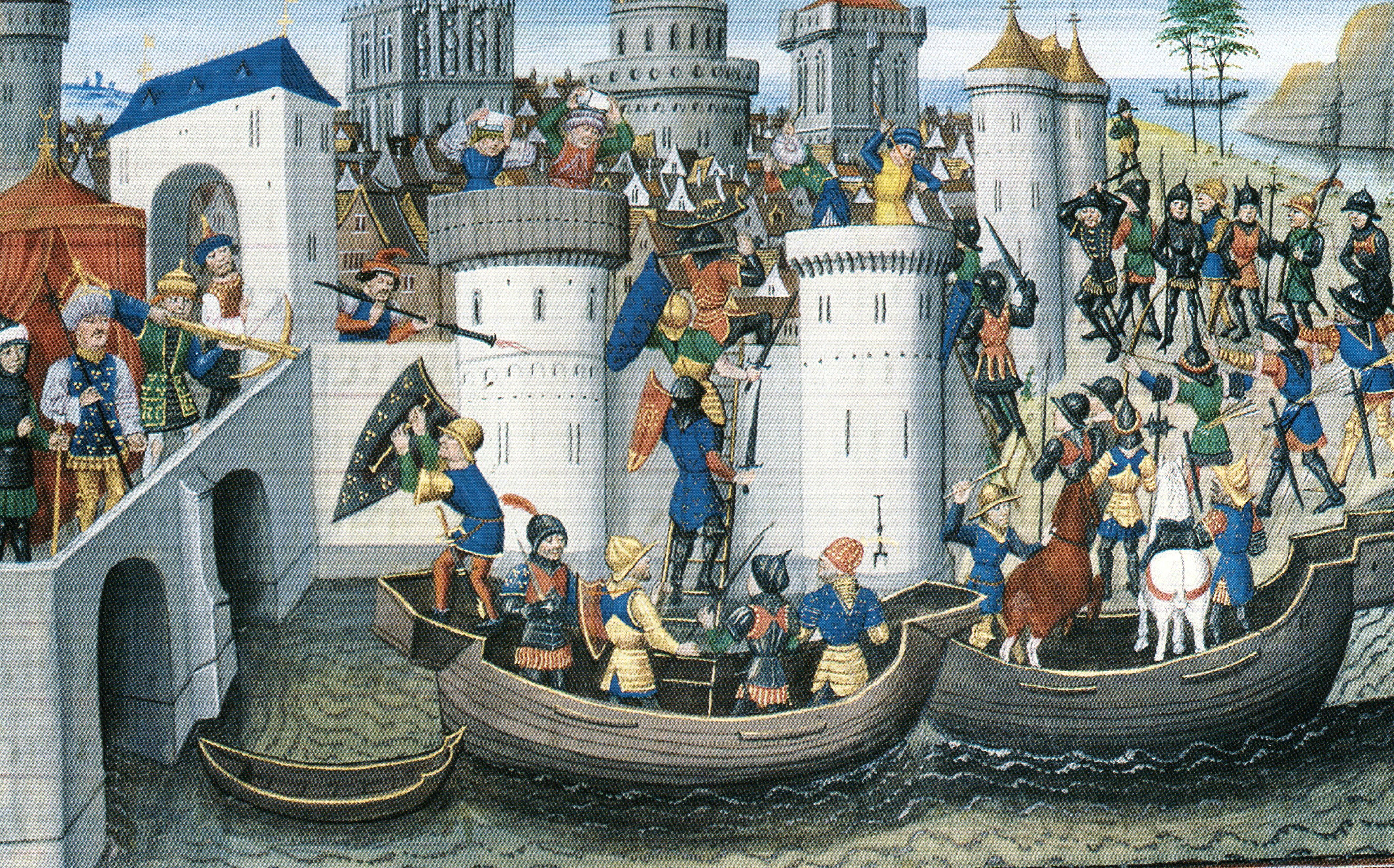|
Alexios III Angelos
Alexios III Angelos (; 1211), Latinized as Alexius III Angelus, was Byzantine Emperor from March 1195 to 17/18 July 1203. He reigned under the name Alexios Komnenos (; Aléxios Komnēnós) associating himself with the Komnenos dynasty (from which he was descended cognatically). A member of the extended imperial family, Alexios came to the throne after deposing, blinding and imprisoning his younger brother Isaac II Angelos. The most significant event of his reign was the attack of the Fourth Crusade on Constantinople in 1203, on behalf of Alexios IV Angelos. Alexios III took over the defence of the city, which he mismanaged, and then fled the city at night with one of his three daughters. From Adrianople, and then Mosynopolis, he attempted unsuccessfully to rally his supporters, only to end up a captive of Marquis Boniface I of Montferrat. He was ransomed and sent to Asia Minor where he plotted against his son-in-law Theodore I Laskaris, but was eventually captured and spe ... [...More Info...] [...Related Items...] OR: [Wikipedia] [Google] [Baidu] |
Cognatic Kinship
Cognatic kinship is a mode of descent calculated from an ancestor counted through any combination of male and female links, or a system of bilateral kinship where relations are traced through both a father and mother. Such relatives may be known as cognates. See also * Matrilineality Kinship through the female line * Patrilineality Patrilineality, also known as the male line, the spear side or agnatic kinship, is a common kinship system in which an individual's family membership derives from and is recorded through their father's lineage. It generally involves the inheritanc ... Kinship through the male line * References Kinship and descent Descendants of individuals {{Anthropology-stub ... [...More Info...] [...Related Items...] OR: [Wikipedia] [Google] [Baidu] |
Stephen Hagiochristophorites
Stephen Hagiochristophorites (; – 11 September 1185) was the most powerful member of the court of Byzantine emperor Andronikos I Komnenos (ruled 1183–1185). He was killed while trying to arrest Isaac II Angelos, who subsequently deposed and replaced Andronikos. Life Stephen Hagiochristophorites was of humble origin. The archbishop Eustathius of Thessalonica records that his father was a tax-collector. In the second half of the reign of Manuel I Komnenos (r. 1143–1180), Hagiochristophorites tried to attach himself to the imperial court, but was confronted by the ridicule and hostility of the aristocracy. Indeed, according to Eustathius, when he attempted to seduce an aristocratic lady and take her to wife to advance his own position, he was publicly flogged and had his nose cut off. Nevertheless, his determination was rewarded, and he was able to climb the administrative hierarchy, finally culminating in the office of administrator of the army, which he apparently receiv ... [...More Info...] [...Related Items...] OR: [Wikipedia] [Google] [Baidu] |
Saladin
Salah ad-Din Yusuf ibn Ayyub ( – 4 March 1193), commonly known as Saladin, was the founder of the Ayyubid dynasty. Hailing from a Kurdish family, he was the first sultan of both Egypt and Syria. An important figure of the Third Crusade, he spearheaded the Muslim military effort against the Crusader states in the Levant. At the height of his power, the Ayyubid realm spanned Egypt, Syria, Upper Mesopotamia, the Hejaz, Yemen, and Nubia. Alongside his uncle Shirkuh, a Kurdish mercenary commander in service of the Zengid dynasty, Saladin was sent to Fatimid Egypt in 1164, on the orders of the Zengid ruler Nur ad-Din. With their original purpose being to help restore Shawar as the vizier to the teenage Fatimid caliph al-Adid, a power struggle ensued between Shirkuh and Shawar after the latter was reinstated. Saladin, meanwhile, climbed the ranks of the Fatimid government by virtue of his military successes against Crusader assaults and his personal closeness to al-Adid. A ... [...More Info...] [...Related Items...] OR: [Wikipedia] [Google] [Baidu] |
Andronikos I Komnenos
Andronikos I Komnenos (; – 12 September 1185), Latinized as Andronicus I Comnenus, was Byzantine emperor from 1183 to 1185. A nephew of John II Komnenos (1118–1143), Andronikos rose to fame in the reign of his cousin Manuel I Komnenos (1143–1180), during which his life was marked by political failures, adventures, scandalous romances, and rivalry with the emperor. After Manuel's death in 1180, the elderly Andronikos rose to prominence as the accession of the young Alexios II Komnenos led to power struggles in Constantinople. In 1182, Andronikos seized power in the capital, ostensibly as a guardian of the young emperor. Andronikos swiftly and ruthlessly eliminated his political rivals, including Alexios II's mother and regent, Maria of Antioch. In September 1183, Andronikos was crowned as co-emperor and had Alexios murdered, assuming power in his own name. Andronikos staunchly opposed the powerful Byzantine aristocracy and enacted brutal measures to curb their in ... [...More Info...] [...Related Items...] OR: [Wikipedia] [Google] [Baidu] |
Irene Doukaina
Irene Doukaina or Ducaena (, ''Eirēnē Doúkaina''; – 19 February 1138) was a Byzantine empress by marriage to the Byzantine emperor Alexios I Komnenos. She was the mother of Emperor John II Komnenos and the historian Anna Komnene. She was initially heavily overshadowed and humiliated in influence and power by her mother-in-law Anna Dalassene, but after her retirement and death, Irene was able to exert increasing influence over her husband Alexios I Komnenos, and became powerful towards the end of his reign. But even so, she could not arrange his successor according to her wishes, which favoured her daughter Anna Komnene over her son John II Komnenos. Life Irene was born in 1066 to Andronikos Doukas (cousin of Michael VII), Andronikos Doukas and Maria of Bulgaria, granddaughter of Ivan Vladislav of Bulgaria. Andronikos was a nephew of Emperor Constantine X Doukas and a cousin of Michael VII. Succession of Alexios Irene married Alexios in 1078, when she was still eleven y ... [...More Info...] [...Related Items...] OR: [Wikipedia] [Google] [Baidu] |
Alexios I Komnenos
Alexios I Komnenos (, – 15 August 1118), Latinization of names, Latinized as Alexius I Comnenus, was Byzantine Emperor, Byzantine emperor from 1081 to 1118. After usurper, usurping the throne, he was faced with a collapsing empire and constant warfare throughout his reign, Alexios was able to curb the Byzantine decline and begin the military, financial, and territorial recovery known as the Komnenian restoration. His appeals to Western Europe for help against the Seljuk Empire, Seljuk Turks were the catalyst that sparked the First Crusade. Although he was not the first emperor of the Komnenos, Komnenian dynasty, it was during his reign that the Komnenos family came to full power and initiated a hereditary succession to the throne. The son of John Komnenos (Domestic of the Schools), John Komnenos and a nephew of Isaac I Komnenos, Alexios served with distinction under three Byzantine emperors. In 1081, he led a rebellion against Emperor Nikephoros III Botaneiates and took ... [...More Info...] [...Related Items...] OR: [Wikipedia] [Google] [Baidu] |
Theodora Komnene (daughter Of Alexios I)
Theodora Komnene or Comnena () may refer to: * Theodora Komnene (daughter of Alexios I) (born 1096), daughter of Alexios I Komnenos, wife of Constantine Angelos and ancestor of the Angelos dynasty * Despina Khatun, Theodora Despina Komnene, daughter of John IV of Trebizond and consort of Aq Qoyunlu's ruler Uzun Hasan * Theodora Komnene Dalassene, sister of Alexios I Komnenos, wife of Constantine Diogenes II * Theodora Komnene, Queen of Jerusalem (born c. 1145), niece of Manuel I Komnenos, wife of Baldwin III of Jerusalem * Theodora Komnene, Duchess of Austria (died 1184), niece of Manuel I Komnenos, wife of Henry II, Duke of Austria * Theodora Komnene, Princess of Antioch (fl. 1140), niece of Manuel I Komnenos, wife of Bohemond III of Antioch {{hndis, Komnene, Theodora ... [...More Info...] [...Related Items...] OR: [Wikipedia] [Google] [Baidu] |
Nicaea
Nicaea (also spelled Nicæa or Nicea, ; ), also known as Nikaia (, Attic: , Koine: ), was an ancient Greek city in the north-western Anatolian region of Bithynia. It was the site of the First and Second Councils of Nicaea (the first and seventh Ecumenical councils in the early history of the Christian Church), the Nicene Creed (which comes from the First Council). It was also the capital city of the Empire of Nicaea following the Fourth Crusade in 1204, until the recapture of Constantinople by the Byzantines in 1261. Nicaea was also the capital of the Ottomans from 1331 to 1335. The ancient city is located within the modern Turkish city of İznik (whose modern name derives from Nicaea's), and is situated in a fertile basin at the eastern end of Lake Ascanius, bounded by ranges of hills to the north and south. It is situated with its west wall rising from the lake itself, providing both protection from siege from that direction, as well as a source of supplies which would ... [...More Info...] [...Related Items...] OR: [Wikipedia] [Google] [Baidu] |
Theodore I Laskaris
Theodore I Laskaris or Lascaris (; 1175November 1221) was the first emperor of Nicaea—a successor state of the Byzantine Empire—from 1205 to his death. Although he was born to an obscure aristocratic family, his mother was related to the imperial Komnenos clan. He married Anna, a younger daughter of Emperor Alexios III Angelos in 1200. He received the title of despot before 1203, demonstrating his right to succeed his father-in-law on the throne. The Fourth Crusade forced AlexiosIII to flee from Constantinople in 1203. Theodore was imprisoned by the crusaders (commonly referred to as "Latins" by the Byzantines), but he escaped. After crossing the Bosporus into Asia Minor (in present-day Turkey), he started to organise the local Greeks' resistance against the Latins in Bithynia in his father-in-law's name. He concluded an alliance with the Seljuq sultan of Rum, but he could not stop the Latins' expansion. Neither could he prevent a claimant to the imperial t ... [...More Info...] [...Related Items...] OR: [Wikipedia] [Google] [Baidu] |
Boniface I Of Montferrat
Boniface I, usually known as Boniface of Montferrat (; ; c. 1150 – 4 September 1207), was the ninth Marquis of Montferrat (from 1192), a leader of the Fourth Crusade (1201–04) and the king of Thessalonica (from 1205). Early life Boniface was the third son of William V of Montferrat and Judith of Babenberg, born after his father's return from the Second Crusade. He was a younger brother of William "Longsword", Count of Jaffa and Ascalon, and of Conrad I of Jerusalem. His youthful exploits in the late 1170s are recalled in the famous "epic letter", ''Valen marques, senher de Monferrat'', by his good friend and court troubadour, Raimbaut de Vaqueiras. These included the rescue of the heiress Jacopina of Ventimiglia from her uncle Count Otto, who was intending to deprive her of her inheritance and send her to Sardinia. Boniface arranged a marriage for her. When Albert of Malaspina (husband of one of Boniface's sisters) abducted Saldina de Mar, a daughter of a prominent ... [...More Info...] [...Related Items...] OR: [Wikipedia] [Google] [Baidu] |
Mosynopolis
Mosynopolis (), of which only ruins now remain in Greek Thrace, was a city in the Roman province of Rhodope, which was known until the 9th century as Maximianopolis (Μαξιμιανούπολις) or, to distinguish it from other cities of the same name, as Maximianopolis in Rhodope. History The city of Maximianopolis appears in written sources from the 4th century on. Its fortifications were renewed by Byzantine emperor Justinian I, and it was later a base for operations by Emperor Basil II in his wars against the Bulgarians. In the 11th century, the city was the center of a district ('' bandon'') in the theme of Boleron, and Anna Komnene reports in her '' Alexiad'' that there were many Manichaeans living in Mosynopolis in the late 11th/early 12th centuries. The town was captured in 1185 by the Normans, while the monk Ephrem says that the city was captured in 1190 by Frederick I, Holy Roman Emperor. The Battle of Messinopolis, in which the Bulgarians defeated Boniface ... [...More Info...] [...Related Items...] OR: [Wikipedia] [Google] [Baidu] |






